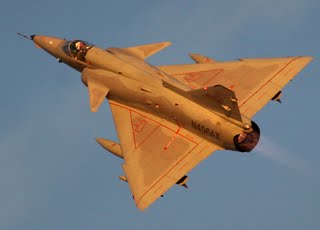


|

|
|
|
Home� |
The Mil & Aero Blog
Posted by John Keller
Few things have given commercial off-the-shelf (COTS) technology a bad name in military systems more often than obsolete electronic parts. These are the chips, diodes, connectors, and other components that generally do not have long shelf lives in commercial electronics, but which when designed into military systems can cause big and continuing headaches. The reason parts obsolescence is so anathema to military systems designers is lack of long-term support that the defense industry culturally has relied on for decades. While desktop computers easily can go out of date every few years, military systems often must function for decades and even longer. Historically, military systems designers relied heavily on a procurement system with long-term spare parts availability, as well as detailed traceability that enabled engineers not only to keep track of where to find spare parts, but also to track the reliability and quality of available spare parts. They gave barely a thought to obsolescence management. No so with COTS parts, for which manufacturers often end-of-life manufacturing lines and parts types with little or no warning to the systems designers who depend on them. What this phenomenon has caused is an across-the-board rethinking of all notions of system sustainment, repair, and technology upgrades. Obsolescence management in the COTS era constantly requires systems designers to rethink how they will repair and upgrade technology over the long term, and so exchanging ideas, successes, mistakes, and lessons learned has taken on profound importance. The opportunity for systems designers to compare notes and learn from one another will present itself in a presentation by Jeff Hanser, chief technology officer for Resource Analysis Corp. in San Diego, at the Military & Aerospace Electronics Forum conference and trade show at 1:30 p.m. Thursday, 2 June at the San Diego Convention Center. Hanser and other panelists will discuss the challenges of obsolescence management related to off-the-shelf parts, as well as possible solutions for managing obsolescence through open systems. Those attending can ask questions, offer their own solutions, and learn from one another during an anticipated lively question and answer period. Register to attend the Military & Aerospace Electronics Forum online at www.pennwellregistration.com/online/LoginServlet?confId=362, by fax at 918-831-9161 with a downloadable .pdf, or by post with the downloadable .pdf to Military & Aerospace Electronics Forum/Avionics USA Conference & Exhibition Registration, P.O. Box 973059, Dallas, TX 75397-3059. Subscribe Follow me on Twitter Join the PennWell Aerospace and Defense Media Group on Linkedin at http://bit.ly/9MXl9 Become a fan of Military & Aerospace Electronics on Facebook at http://bit.ly/1VGM0Q Post your aerospace and defense-related material to the #milaero community on Twitter. Use the #milaero hashtag. 0 Comments:
DSP performance of the Intel Core i7 microprocessor: the hits just keep on comingTuesday, March 30, 2010
Posted by John Keller
CHANDLER, Ariz. -- Just when embedded computing developers are getting used to the benefits of the Intel Core i7 microprocessor, such as floating-point processing for high-performance digital signal processing (DSP), they have something new to get excited about. The DSP performance of the Core i7, for some applications, is about to double. This should be welcome news for embedded computer developers for DSP-heavy applications like radar processing, signals intelligence, and electronic warfare. Better yet, Intel chip designers will not change the dimensions or pin connections of the new Core i7 microprocessors, which means single-board computer designers will be able to integrate these chips without redesigning the boards. Peter Carlston, platform architect of the Intel Corp. Embedded and Communications Group in Chandler, Ariz., says Intel will offer versions of the Core i7 early next year with vector registers increased from four to eight. That means the chip's floating point operations will increase from four operations per clock cycle to eight operations -- effectively doubling the chip's floating point performance. This will have two primary benefits for DSP applications designers Carlston explains. They either can do more work in the same size, weight, and power footprint, or they can do the same work in a smaller footprint. Imagine what that could mean for new generations of unmanned vehicles and soldier systems. All this should happen by the first quarter of 2011. subscribe Follow me on Twitter Join the PennWell Aerospace and Defense Media Group on Linkedin at http://bit.ly/9MXl9 Become a fan of Military & Aerospace Electronics on Facebook at http://bit.ly/1VGM0Q Post your aerospace and defense-related material to the #milaero community on Twitter. Use the #milaero hashtag.  Posted by John Keller The administration of Barack Obama is orchestrating an arms embargo of sophisticated military weapons against the only reliable U.S. ally in the Middle East -- Israel. How much sense does this make at a time when nearby Iran is nearing development of deliverable nuclear weapons and is belligerent as ever? If the U.S. and Israel do not stand united against a nuclear-armed Iran, the entire geopolitical situation in South Asia could slip out of control. In my darker moments I think this must be what the Obama Administration wants. So what's the problem between the U.S. and Israel? The Israelis and Palestinian Arabs don't like each other much, and the Obama Administration wants the two sides to get along. Israel wants to build 1,600 housing units in East Jerusalem -- an area that has been part of Israel for 43 years -- and the Obama Administration wants the project stopped because it offends Palestinians. The Obama Administration can't resist intervening in an internal Israeli matter so much that the president is willing to aid and abet a nuclear-armed adversary nearby to develop into a monster international threat. This doesn't sound to me like Obama has his international priorities straight, but I digress. So what's this arms embargo? Since taking office, Obama has blocked all major Israeli requests for advanced U.S. weapons, including proposed Israeli procurement of AH-64D Apache attack helicopters, refueling systems, advanced munitions and data on a stealth variant of the F-15E fighter-bomber. According to a story that ran Thursday in the World Tribune, "All signs indicate that this will continue in 2010," a congressional source familiar with the Israeli military requests said. "This is really an embargo, but nobody talks about it publicly." The latest development in Obama's arms embargo against Israel happened Thursday. World Tribune reported the Administration ordered the U.S. military to divert a shipment of smart bunker-buster bombs from Israel to a military base in Diego Garcia. They said the shipment of 387 smart munitions had been slated to join pre-positioned U.S. military equipment in Israel Air Force bases. The Obama Administration can posture with an arms embargo all it wants, but Israel has an interesting history of dealing with arms embargoes. After the 1967 War, the French government launched an arms embargo, which denied the French-build Mirage 5 jet fighter to Israel. By controversial means, Israel acquired detailed plans for the Mirage 5 and build their own jet fighter based on its design. The result was the Kfir jet fighter, which is Hebrew for lion cub. My point is that if the Israelis want bunker-busting munitions, they are perfectly capable of developing these big smart bombs on their own. Israel does amazing things when the country feels threatened; they have shown this throughout their short history. Put a nuclear-capable country within the range of short-range ballistic missiles near their borders, and I think Israel pull another rabbit out of its hat -- and the Obama Administration will have nothing to say about it. Subscribe Follow me on Twitter Join the PennWell Aerospace and Defense Media Group on Linkedin at http://bit.ly/9MXl9 Become a fan of Military & Aerospace Electronics on Facebook at http://bit.ly/1VGM0Q Post your aerospace and defense-related material to the #milaero community on Twitter. Use the #milaero hashtag. 7 Comments:
 Posted by John Keller I know that Military & Aerospace Electronics is read by influential figures in and out of the aerospace and defense industry, but I never realized that our magazine also is the journal of choice for at least one superhero. It seems the Green Lantern, a test pilot who is granted a mystical green ring bestowing him with otherworldly powers, as well as membership in an intergalactic squadron tasked with keeping peace within the universe, also is among our subscribers. Hey, don't look at me; I was as surprised as you. I'm pretty sure the Green Lantern's Mil & Aero subscription is in a different name -- otherwise our circulation department would have let me know a long time ago, right? Here's the deal: a summer action movie blockbuster is scheduled for release in June 2011, tentatively entitled The Green Lantern, that will have a plot along the lines of other recent movie releases that are based on comic book characters from DC comics, Marvel, and others -- you know, Spider-Man, Superman, Iron Man, The Incredible Hulk. This time, though Military & Aerospace Electronics just might have a bit part in the movie. Production on the movie has begun, and set designers contacted me the other day asking for issues of the magazine. It's possible -- based on how the final movie is edited -- that issues of Military & Aerospace Electronics will be part of airport scenes in the Green Lantern movie. We'll see how this develops. Stay tuned. 2 Comments:
Posted by John Keller
The Obama Administration's military budget proposals for next year are out, and I think we can all breathe a collective sigh of relief. The aerospace and defense industry has spent months fretting about President Obama's 2011 defense budget -- more out of uncertainty than fear. It is this proposed budget, far more than the one last year, that gives us our first clear indication of how the Obama Administration plans to treat defense spending, and the verdict is, better than we thought. The Administration's 2010 DOD budget request for the U.S. Department of Defense (DOD) last year essentially was George W. Bush's last defense budget. It wasn't until the 2011 budget proposal was released earlier this month that we see clearly how Obama wants to proceed with defense spending. The numbers speak for themselves. The overall DOD budget is $708 billion, which consists of $549 billion in the discretionary defense budget, and $159 billion to support continuing military operations in Iraq and Afghanistan. The discretionary DOD budget of $549 billion -- which includes proposals for military personnel, military construction, and family housing, in addition to military procurement, research and development, and operations and maintenance -- is an increase of $18 billion over the $531 billion enacted for 2010. This is an increase of 3.4 percent, or 1.8 percent real growth after adjusting for inflation, DOD officials say. Those top-line budget numbers, fail to convey the real story for the aerospace and defense electronics industry. To do this requires us to look closely at DOD budget for procurement, as well as the budget for research, development, test, and evaluation (RDT&E), because these budgets largely deal with current and future military technologies. The 2011 DOD procurement budget asks Congress for $137.48 billion, which is up only slightly -- 1.05 percent -- from current-year procurement spending of $136.06 billion, yet the trend is clearly going in the right direction -- particularly in light of concerns that the Obama Administration was looking to cut defense spending. RDT&E is another story. The proposed military research budget for next year is $76.77 billion, which is down 5.13 percent from current-year spending of $80.92 billion, but was not as drastic a cut as it could be. Now take a look at the combined procurement and RDT&E budget lines for military communications, electronics, telecommunications, and intelligence (CET&I) technologies. Next year's CET&I proposed budget is for $17.45 billion, which is an increase of 3.2 percent from this year's CET&I congressionally enacted spending levels of $17.45 billion. All this is good news for the military electronics and electro-optics industries. It means we can be on solid ground as we plan for the future. Barring unforeseen circumstances, I don't think we are going to see substantial defense spending cuts over at least the next several years; there is simply not the political will to do so. President Obama's agenda seems to revolve around domestic programs; for defense spending it's steady as she goes -- at least for now. If the Administration were intent on cutting defense spending, this 2011 budget was the one where this was most likely to happen, especially with a Democrat-controlled Congress that had appeared compliant to the Administration's wishes. Now we're into an election year, and no one in the Administration or on Capitol Hill wants to rock the boat on defense spending and preparedness as we move closer to the congressional mid-term elections next November. Again, barring unforeseen circumstances, we are not likely to see substantial increases in defense spending over the next several years, yet we are not likely to see major cuts, either. So for all of you out there who have been in mental, political, and financial holding patterns, it's time to break out and start moving forward. I don't see any end in sight in the global war on terror -- ooops, sorry ... the "overseas contingency operations" -- which means we'll see a continuing solid market for advanced sensors, battlefield networking, optics and fire control, and many other new technologies that will be involved in counter-terror and counter-insurgency operations. Everyone involved in the military technology business can get to sleep tonight, resting assured, that the Department of Defense is still open for business.  Posted by Courtney E. Howard Former U.S. Homeland Security Secretary Tom Ridge and General Tommy Franks, USA (Ret.), honorary co-chairs of the Flight 93 National Memorial Campaign, issued the following statement for Presidents' Day: "What better time than Presidents' Day, when America celebrates those who have held its highest office, to remember the heroes who protected targets such as the White House or the Capitol from a terrorist attack? The 40 passengers and crew aboard United Flight 93 changed history on September 11, 2001 when they fought back to take control of their plane, diverting it from its intended targets, and crashing into the remote fields outside of Shanksville, Pa. "We are making great progress on this important memorial. With the groundbreaking behind us and the first construction contract awarded, the memorial has entered a new building phase that will culminate with its dedication on September 11, 2011. "More than 57,000 donors - both large and small from across the nation and around the world - have raised over $17 million for the memorial. Another $28 million in public funds are expected toward the estimated $58 million cost of the memorial's first phase. We hope all Americans will consider lending their support and building on the growing momentum for this important symbol of our democratic values on this key national holiday. "Like some of our greatest presidents, the heroes of Flight 93 risked all and gave all to protect and preserve our freedoms. Americans can appropriately honor these heroes and ensure their actions are remembered by helping to build the Flight 93 National Memorial." The Flight 93 National Memorial is the only national park unit dedicated to the events of September 11, 2001. The memorial park sits on 2,231 acres in Somerset County, site of the plane's crash, approximately 80 miles outside Pittsburgh. The memorial will include the final resting places of the heroes as well as visitor facilities and related infrastructure. For information on how to contribute to the memorial, visit www.honorflight93.org.  Posted by Courtney E. Howard Each year at this time, I scramble to view as many Oscar contenders as I can before the award ceremony is held (March 7, this year). Nominees will be announced on Feb. 2, so nothing is official as yet, but the industry is still buzzing with speculation. Years ago, I had the privilege of covering digital content creation as a senior technical editor of a monthly trade publication on computer graphics and visual effects technologies, trends, and techniques. Today, I enjoy the benefit of seeing my previous and present roles converge; that is, a majority of today's coolest, eye-catching, and awe-inspiring films (and games, for that matter) incorporate a military, aerospace, and electronics vein. Heck, I would even wager that Cloudy with a Chance of Meatballs includes a military aspect. As I endeavor to take in as many soon-to-be-nominated films as possible, I am impressed by the majority that have a military or aerospace component this year. Now, I am not implying that the films I mention here will be nominated for an Academy Award. (I have no psychic abilities, plus some of them I could not bring myself to finish watching--namely the Transformers sequel.) Nonetheless, I will admit that I found each of the following to be novel in some way, many with regard to the advanced electronics employed in mil-aero missions and environments. The films include: Terminator: Salvation (this movie, in particular, included a display from Digital Systems Engineering and server from Crystal Group--something I blogged about earlier this year) Star Trek Avatar District 9 The Hurt Locker Moon Inglorious Basterds Monsters vs. Aliens 9 X-Men Origins: Wolverine Transformers: Revenge of the Fallen GI Joe: Rise of Cobra My favorite, by far, was Avatar. When I was in Seattle a month or so ago, the Seattle Science Fiction Museum was handing out free tickets to see Avatar at the Boeing IMAX Theater but they ran out. Rats! The trip was not wasted, however, as I was treated to a tour of the Future of Flight Museum and Boeing's facility in Everett, Wa. I highly recommend it if you're in the area (I will describe the visit in detail in a coming blog, and you can follow the Future of Flight on Twitter (#futureofflight) for some entertaining and interesting news and insights. I finally saw Avatar just last night in 3D, and it was phenomenal. One of my geekier friends who attended with me (for his third time) called it "pure bliss." It was two hours and 40 minutes that passed in what seemed the blink of an eye--although I am sure I kept my blinking to a minimum, with eyes wide. It's the 3D CG (computer graphics) I have been waiting for since I was a kid--and I felt a bit like one watching, in awe. Bravo to the industries that put out such creative films, and also to the mil-aero community that inspires them. |
Welcome to the lighter side of Military & Aerospace Electronics. This is where our staff recount tales of the strange, the weird, and the otherwise offbeat. We could put news here, but we have the rest of our Website for that. Enjoy our scribblings, and feel free to add your own opinions. You might also get to know us in the process. Proceed at your own risk. 
John Keller is editor-in-chief of Military & Aerospace Electronics magazine, which provides extensive coverage and analysis of enabling electronic and optoelectronic technologies in military, space, and commercial aviation applications. A member of the Military & Aerospace Electronics staff since the magazine's founding in 1989, Mr. Keller took over as chief editor in 1995.  Courtney E. Howard is senior editor of Military & Aerospace Electronics magazine. She is responsible for writing news stories and feature articles for the print publication, as well as composing daily news for the magazine's Website and assembling the weekly electronic newsletter. Her features have appeared in such high-tech trade publications as Military & Aerospace Electronics, Computer Graphics World, Electronic Publishing, Small Times, and The Audio Amateur.
Courtney E. Howard is senior editor of Military & Aerospace Electronics magazine. She is responsible for writing news stories and feature articles for the print publication, as well as composing daily news for the magazine's Website and assembling the weekly electronic newsletter. Her features have appeared in such high-tech trade publications as Military & Aerospace Electronics, Computer Graphics World, Electronic Publishing, Small Times, and The Audio Amateur.
 John McHale is executive editor of Military & Aerospace Electronics magazine, where he has been covering the defense Industry for more than dozen years. During that time he also led PennWell's launches of magazines and shows on homeland security and a defense publication and website in Europe. Mr. McHale has served as chairman of the Military & Aerospace Electronics Forum and its Advisory Council since 2004. He lives in Boston with his golf clubs.
John McHale is executive editor of Military & Aerospace Electronics magazine, where he has been covering the defense Industry for more than dozen years. During that time he also led PennWell's launches of magazines and shows on homeland security and a defense publication and website in Europe. Mr. McHale has served as chairman of the Military & Aerospace Electronics Forum and its Advisory Council since 2004. He lives in Boston with his golf clubs.
Previous Posts
Archives
|
|||
|
THE MAE WEBSITE AUTHORS ARE SOLELY RESPONSIBLE FOR THE CONTENT AND ACCURACY OF THEIR BLOGS, INCLUDING ANY OPINIONS THEY EXPRESS, AND PENNWELL IS NOT RESPONSIBLE FOR AND HEREBY DISCLAIMS ANY AND ALL LIABILITY FOR THE CONTENT, ITS ACCURACY, AND OPINIONS THAT MAY BE CONTAINED HEREIN. THE CONTENT ON THE MAE WEBSITE MAY BE DATED AND PENNWELL IS UNDER NO OBLIGATION TO PROVIDE UPDATES TO THE INFORMATION INCLUDED HEREIN.
|
||||
|
|
Home�|�About Us�|�Contact Us�|�Corporate Website�|�Privacy Policy�|�Courage and Valor Foundation�|�Site Map
Also Visit: Laser Focus World�|� Vision Systems Design�|� Industrial Laser Solutions Copyright � 2007: PennWell Corporation, Tulsa, OK; All Rights Reserved.�|�Terms & Conditions�|�Webmaster |